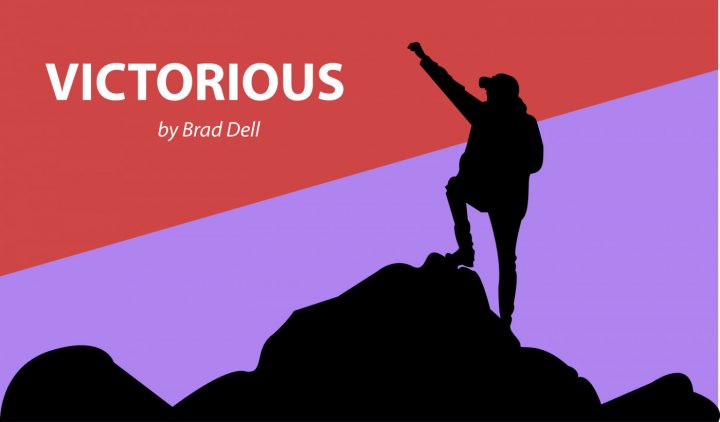In Cystic Fibrosis Awareness Month, I Look Back to Anticipate the Future
Written by |

The night I received my first Hill-Rom Vest — at age 5 — was a fun one. It was a beast of a machine in the mid-1990s, a white box weighing maybe 50 pounds. Large, plastic, hollow coils connected the machine to a bulky, black vest, which fitted around my torso and shoulders. The goal of the Vest is to shake the mucus right out of patients’ airways. Yeah, the Vest literally just shakes those rib bones.
In those days, I had to step on a pedal to make the machine shake — it didn’t have those fancy automatic settings the sleek, small machines now have. Each time I’d step on the pedal, I’d imagine I was blasting off in a rocket. (For a CF Foundation art contest, I drew a rocket ship surrounded by 65 roses next to the words, “Blasting off to a cure!”)
My disease wasn’t yet a monster to me. “CF” was an acronym and not much more. Hospitalizations meant I got to play in the ward’s arcade room and my parents would focus only on me and the coloring books we’d do together. The worst of my symptoms were heartburn, coughing, and weight loss. I didn’t think about the social dilemmas of chronic illness or insurance troubles or transplantation. I didn’t know that my mom spent sleepless nights praying through tears. I didn’t know my sister listened through the crack of my door at night to ensure I was still breathing.
That first night with my Vest, I sang “Mary Has a Little Lamb” with a shaky voice, like a baa-ing sheep, while my family laughed. My family believed the Vest would save me. Funny, thinking back on that. The Vest, important as it was and is, pales in efficacy compared to the therapeutic arsenal we now possess.
That night, in the laughter, I didn’t realize the Vest wouldn’t help me as much as hoped. Or that I’d grow to despise it, and that it would collect dust while my family and teenage Brad shouted at each other about his fading will to live. I refused to continue fighting CF. The acronym corrupted my identity and had become a monster.
Hospitalizations meant torturous pain and prognoses and constant reminders of death. My symptoms included deafness, stabbing sensations in my chest, chronic fatigue, frequent vomiting, and malnourishment. I was alienated from my peers and unintentionally insulted daily. At age 17, I already had anxiety about securing insurance as an adult or needing the dreaded lung transplant. I knew my family wanted desperately for me to live, but I didn’t care.
In adulthood, astounding medicinal advances hit the scene. Novel CFTR modulators pumped veins with hope of long lives. Vests became portable and could even be used while hiking. I embraced the acronym, CF, as a source of pride — I became a CFer who is highly involved in the disease community. I saw myself as a survivor who knows how to take care of himself.
Thanks to advances in science, I made it to my lung transplant. My symptoms now include slightly unsteady weight, a drippy nose, some tiredness, and overly ambitious living. I don’t go to the hospital aside from six-month checkups. I now write to help others overcome fears of transplant and problems with social life in the midst of illness. I secured insurance just this morning because my newfound health allowed me to obtain my dream job. I now thank my family for pushing me to take care of myself even though teenage Brad was a jerk to them. I didn’t try my best, back in the day, but their insistence got me to where I am today — a season of thriving.
May is Cystic Fibrosis Awareness Month. Disease awareness encompasses many facets: physical and mental symptoms, social and emotional challenges, community strength, scientific progress. Awareness is about looking back and looking forward to address how we got to here and how we get to there.
I recently spoke to the dad of a newborn daughter diagnosed with CF. He said he was exhausted by people telling him his baby was born in an ideal time of CF science, that his daughter will get the best care offered in the history of treating this disease. I understand his exhaustion. Comfort should include mourning alongside a person, not only peppy messages of optimism. On the other hand, I do hope he can one day think back on the early days of his daughter’s CF and realize, like my old Vest, the big CFTR modulators, phage therapies, and portable treatments were just the beginning of something bigger — a cure.
I hope his daughter gets that cure before she grows into those rebellious teenage years. I hope her memory of singing “Mary Has a Little Lamb” during Vest treatments is free of bitterness.
For Cystic Fibrosis Awareness Month, let’s celebrate progress both made and imminent, but also remember that we must share the reality of this disease’s horrors until it’s done. We’re so close, friends.
***
Note: Cystic Fibrosis News Today is strictly a news and information website about the disease. It does not provide medical advice, diagnosis, or treatment. This content is not intended to be a substitute for professional medical advice, diagnosis, or treatment. Always seek the advice of your physician or other qualified health provider with any questions you may have regarding a medical condition. Never disregard professional medical advice or delay in seeking it because of something you have read on this website. The opinions expressed in this column are not those of Cystic Fibrosis News Today, or its parent company, Bionews Services, and are intended to spark discussion about issues pertaining to cystic fibrosis.







Pam
Always truthful and transparent. My son Josh died Oct. 5, 2017. He had gotten so close to transplant, already spoke with surgeon, everything. Pulling for you Brad!